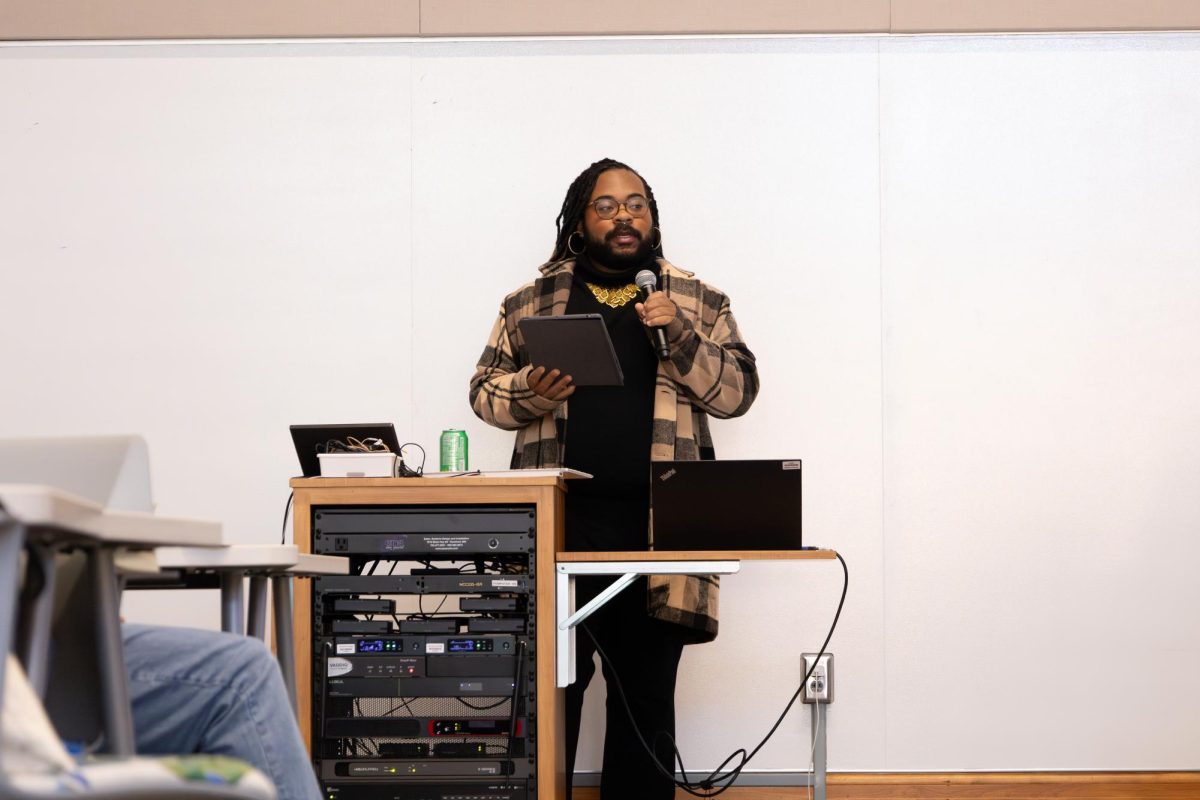Dance is prevalent in Carleton’s culture, including numerous student organizations such as Synchrony II, Karl Pop and Jazz Contemporary Dance Company (JCO). Partnered dance is just as popular. From Social Dance Club (SDC) and Monday Night Swing (MNS) to the competitive ballroom team and PE classes, versatility and community keep Carleton’s social dance scene lively.
Madeline Morrison ’26 became involved in Monday Night Swing the fall of her freshman year. “We were trying out new things,” she said. Since then, she’s been an active participant both in the club and the Lindy Hop PE classes. She initially stayed “[b]ecause someone was there and taught us basic moves right away, so we weren’t just standing on the side.”
Rahim Hamid ’26 became involved in Social Dance Club through their New Student Week leader, Marta Kondratiuk ’25. “She invited me to [SDC] which she ran at the time, and it seemed like a fun way to pass an evening,” they said. “I had the time, and I went with a friend.”
“Honestly, it was two things,” Hamid said of why they’ve continued dancing into their sophomore year. “Firstly it was the physical activity of it. I’ve never been any good at dance, so it was a really interesting challenge to learn. I’m not very musical either, so learning how to count the time […] along with moving your body in very specific ways. Then also having another person dancing with you, because social dance is fundamentally a partner dance, no matter what style you’re doing.”
Hamid continued, “The second part was the community. I’ve found some of the best people on campus while doing it: they’re super passionate about the activity, about competing and improving, but also just having a good time, which I think is an aspect of dance that Carleton gets right.”
“The community is what kept me coming back more than just how interesting dance is by itself,” Hamid said. Carleton’s ballroom team focuses not only on competition but also on joy and artistic expression: they host a showcase of their own choreography each spring. Furthermore, at competitions, Hamid said that while Carleton performs well in general, its team is concerned more with the learning experience than winning every time.
For Hamid, the actual experience of a partnership dance is grounding. In all styles of social dance — be that waltz, rumba or swing — pairs are split into leads and follows. Leads are “making the decisions whereas [follows] respond to those decisions — the decisions being different moves and where you’re going on the dance floor.”
“Trying to convey to [follows as a lead] where you want them to go or what you want them to do through very subtle changes in posture, pressure via your hands or even looking in a certain direction… you become extremely aware of what you’re doing in a present moment,” Hamid said. “During a term that runs so fast that I scarcely remember where I am half of the day, it’s actually really nice to be aware of what I’m doing and why I’m doing it.”
“It’s an exercise in trust as well. Your follow… is always trusting you to not run them into a wall or into another person,” Hamid said as well. “You can get concussions from doing dance — it’s more common than you think. That is an immense amount of trust to place in somebody: to lead you in a way to where you don’t get injured… It’s a really interesting exercise in both awareness and trust.”
Community is an aspect that makes MNS fun for Morrison too. She said, “It’s a fun way to get a little bit of exercise and see people I’m friends with.” As a swing dancer, she said, “[Lindy Hop] can be exciting; it can be fun to learn new moves or improvise, and do things on your own.”
The club’s leaders motivated Morrison as she first learned Lindy Hop last yearL “As someone who’s not very coordinated, it was not very hard to pick up, and the teachers were very patient and understanding that everyone had a different background.”
“The seniors who graduated last year were very enthusiastic,” said Morrison. “They had to deal with [the] COVID year taking away a lot of opportunities for people to learn the dance since they couldn’t have the dance classes or the club at the time. They were trying to save a dying club.”
The Lindy Hop PE classes last year, taught by Hannah Rosenberg ’23 and Karina Yum ’23, address not only the dance but also its culture and history. Lindy Hop originated in the African-American community, along with the Charleston and tap, in the first half of the 1900s and became appropriated into what is now East Coast Swing. Morrison said, “I thought [incorporating the history of Lindy hop and swing into the PE class] was important for understanding the dance.”
“The music can be very fun to dance to,” she said. “[The songs] are usually very lively and have good musical quality. They’re usually songs done with a band, as opposed to something you might hear on the radio.”
Stella Pinto ’26 is taking the Social Dance PE class this fall and had similar things to say about her experience. “I enjoy social dance! It’s nice to learn new dances and get better at them. It’s definitely a little awkward having to change partners a lot, but my class kinda gave up on the whole ‘high-five rotate’ deal,” she said. “The teachers are very nice and understanding when we don’t understand how to do various moves. It’s definitely hard at times coordinating my limbs, but it’s rewarding when I can make it through a whole song without messing up.” When asked if she could foresee herself continuing, Pinto said, “I would definitely keep Social Dance II on my radar because it sounds like fun!”
Commenting on why they think social dance is so popular, Hamid cited its practicality: “I feel as though it’s a more universal skill.” They said, “You’re likely to find yourself in a situation at least once, where you’re at a wedding, maybe a function, maybe a party, who knows, and you get the urge [to dance]. I think a lot of us have found ourselves in situations where… we’re sort of awkwardly shuffling, not really knowing what to do with our body.”
“It doesn’t matter what style of dance, what any form of dance teaches you is fundamentally how music interacts with the human body, how it affects our sense of balance, our rhythm, our movements,” they said. Even by attending a biweekly PE class, dancers of any technical level can gain confidence in their movement. Along with the functionality of knowing social dance, Hamid said, “It’s just a cool thing to know.”
Both clubs are open for anyone to drop by — MNS on Mondays from 8-9:30 p.m. and SDC on Wednesdays from 9:15-10:45 p.m. — and the PE classes run all year. Morrison commented, “I wish more people did it, because it’s so much fun dancing with new people. It feels like a party almost.”
Rahim Hamid ’26 is a Viewpoint editor with the Carletonian.











